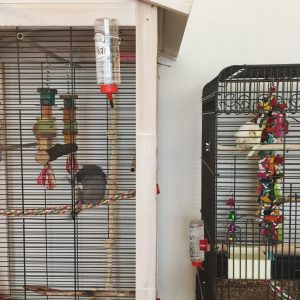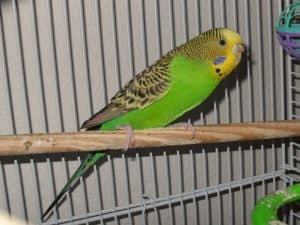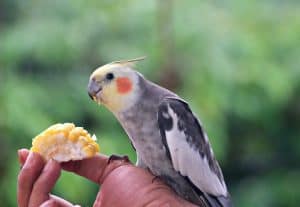Welcoming a cockatiel into your home is an exciting and joyful experience. These delightful birds, known for their playful and affectionate nature, quickly become beloved members of the family. However, ensuring your new feathered friend’s happiness and comfort involves more than just providing a spacious cage and a nutritious diet. To fully meet your cockatiel’s needs and enhance their quality of life, it’s crucial to invest in a range of accessories.
In this guide, we’ll answer the question, “What other accessories do you need to buy for your cockatiel?” We’ll cover everything from setting up the perfect bird cage to choosing interactive toys that keep your pet entertained. Additionally, we’ll discuss the importance of a balanced diet and specialized items like foraging toys and water dishes. Whether you’re a new cockatiel owner or looking to enrich the life of your current pet, this post will help you create an ideal environment for your cockatiel’s well-being.
Cockatiel’s Cage Essentials

Cage Size and Bar Spacing
When setting up a cockatiel’s cage, the size and design are crucial factors that affect your bird’s comfort and safety. Cockatiels are active birds that need ample space to move around, stretch their wings, and climb. Therefore, selecting a cage with adequate dimensions is essential. A bird’s cage that is too small can lead to stress and health issues, while a larger cage allows your cockatiel to exercise and play, which contributes to a healthier and happier bird.
Bar spacing is another critical aspect of cage selection. The bars should be spaced close enough to prevent your cockatiel from escaping or getting stuck between them. For cockatiels, a spacing of about 1/2 to 5/8 inches is usually ideal. This spacing ensures safety while allowing your bird to explore its environment freely.
Cage Placement
The placement of your cockatiel’s cage within your home also affects their well-being. It’s best to position the cage in a room where your bird can be part of daily family activities without being directly in the way. Avoid placing the cage in areas with high traffic or near other pets like dogs or cats, as this can cause stress. Additionally, ensure the cage is away from direct sunlight, drafts, and extreme temperatures to maintain a comfortable environment for your cockatiel.
Perches and Climbing Opportunities

Variety of Perches
Bird perches are essential accessories for your cockatiel’s cage, offering more than just a place to rest. They come in various materials and shapes, each providing unique benefits for your bird’s physical health and comfort. Cockatiels enjoy perches of different textures and diameters, which help keep their feet healthy and prevent issues like foot sores or deformities.
Natural wood perches are excellent because they mimic the branches your cockatiel would encounter in the wild. These perches not only provide a comfortable place to perch but also offer a natural way to trim their beak and claws. Rope perches are another popular option, offering flexibility and comfort. They can be shaped to encourage climbing and exploration, which is beneficial for your cockatiel’s physical exercise.
Encourage Climbing
Incorporating climbing opportunities in your cockatiel’s cage is essential for their physical and mental stimulation. Cockatiels love to climb and explore, and providing various types of perches and platforms can help encourage this natural behavior. You can add ropes, ladders, and branches to create a stimulating environment that keeps your cockatiel active and engaged.
Foraging toys are also a great addition. These toys encourage your cockatiel to work for their food, mimicking natural behaviors and providing mental stimulation. Foraging toys can be filled with treats or hidden food to challenge your bird and prevent boredom.
Bird Toys for Enrichment

Types of Toys
Bird toys play a vital role in keeping your cockatiel entertained and mentally stimulated. There is a wide range of toys available, each designed to cater to different aspects of your bird’s natural behaviors. Foraging toys, for example, encourage your cockatiel to search for hidden treats or food, mimicking the activities they would engage in the wild. These toys help stimulate your bird’s mind and prevent boredom.
Enrichment toys are another excellent choice. These include items like puzzle toys, bells, and mirrors that provide interactive play. Such toys not only engage your cockatiel but also help in developing their problem-solving skills. When selecting toys, consider those that are safe and free from small parts that could pose a choking hazard.
Interactive Play
Engaging your cockatiel with toys is more than just a way to keep them occupied; it’s crucial for their emotional and mental well-being. Interactive play can strengthen the bond between you and your bird while providing necessary mental stimulation. Incorporate a mix of foraging toys, bells, and shreddable toys to cater to your cockatiel’s varied interests and prevent them from becoming bored.
Toys to Avoid: Not all toys are suitable for cockatiels. Avoid toys with small parts or those made from unsafe materials like untreated metal or plastic. Additionally, steer clear of toys that can easily break apart and become a choking hazard.
Feeding Accessories
Water Dishes/Bowls
Water dishes or bowls are fundamental accessories that ensure your cockatiel has constant access to clean, fresh water. Place a water dish in a location that is easily accessible but not directly under perches to prevent contamination from droppings. Regularly clean the water dish with a clean spray bottle to prevent bacterial growth and ensure your cockatiel always has access to clean water.
Food Dishes
Having separate dishes for food and water is crucial for maintaining a clean feeding area. Ensure the food dish is large enough to accommodate the amount of food your cockatiel consumes daily but not so large that it leads to waste. Regularly check and refill the food dishes with a balanced diet that includes seeds, pellets, fruits, and vegetables.
- FOR SMALL BIRDS The Crinkle Crinkle Little Star bird toy by Super Bird Creations is the perfect size for perfect size for Parrotlets, Parakeets, Cockatiels, Lovebirds and similarly sized pet birds.
- DESIGN FEATURES This delightful bird toy is crafted with the finest quality natural vine components, colorful plastic beads, crinkle shred and bird-safe hardware.
- ENRICHMENT BENEFITS - The Crinkle Little Star bird toy is designed to not only entertain but also to satisfy a pet bird's instinctual drive to chew. Birds will also enjoy pulling and preening the crinkle shred.
- RELIEVES BOREDOM Properly designed bird toys are more than just toys. Super Bird Creations parrot toys are Playthings with a Purpose that help to ward off boredom, depression, aggression and destructive behaviors in parrots by stimulating physical activity, curiosity and mental engagement.
- Bird safe components & design Recommended by avian professionals worldwide, our products are expertly designed to maximize the safety and enrichment benefits to pet parrots. Bird owners can be confident that only the finest toy components are used. Proudly assembled in the USA since 1992.
Types of Food
The cockatiel’s diet should be varied and nutritious to promote overall health. A balanced diet includes:
- Seeds: A staple in many cockatiels’ diets, but should not be the sole food source due to high fat content.
- Pellets: Provide essential vitamins and minerals that may be lacking in a seed-only diet.
- Fruits and Vegetables: Fresh produce such as leafy greens, carrots, and apples offer additional nutrients and variety.
- Occasional Treats: Items like millet spray can be used as occasional treats but should not replace a balanced diet.
Millet Spray and Treats
Millet spray is a favorite among many cockatiels and can be a great tool for training or rewarding good behavior. However, it should be given in moderation to avoid excess calories and ensure your cockatiel maintains a balanced diet.
Cage Maintenance and Cleaning
Clean Spray Bottle
Maintaining a clean cage is essential for your cockatiel’s health. A clean spray bottle can be used to disinfect the cage and accessories regularly. Use bird-safe cleaning solutions and avoid harsh chemicals that can harm your cockatiel. Clean all surfaces of the cage, including perches, food dishes, and toys.
Regular Cleaning
Routine cleaning helps prevent the buildup of bacteria and mold, which can lead to common illnesses in birds. Remove soiled bedding, clean food and water dishes daily, and perform a more thorough cleaning of the cage weekly. Ensuring a hygienic environment is crucial for preventing health issues and maintaining a happy, healthy bird.
Water and Food Dish Cleaning
Clean the water dish and food dishes daily to prevent contamination. Use warm water and mild, bird-safe soap for cleaning, and rinse thoroughly to remove any residue. Regularly check the dishes for any signs of wear or damage, and replace them as needed to ensure your cockatiel’s safety.
Health and Veterinary Care
Avian Veterinarian
Regular check-ups with an avian veterinarian are essential for monitoring your cockatiel’s health. An avian vet specializes in bird care and can provide valuable advice on diet, behavior, and overall well-being. Regular visits can help catch any potential health issues early and ensure your cockatiel stays in good health.
Common Health Issues
Be aware of common health issues that can affect cockatiels, such as respiratory infections, feather plucking, and dietary imbalances. Signs of illness can include changes in droppings, lethargy, or changes in appetite. If you notice any of these symptoms, consult your avian vet promptly for advice and treatment.
Feather Plucking and Other Health Concerns
Feather plucking is a common issue that can be caused by various factors, including stress, boredom, or health problems. If your cockatiel is plucking feathers, it’s important to address the underlying cause, which may involve changes in their environment, diet, or seeking professional veterinary help. Regular check-ups and attentive care can help prevent and manage such issues.
Transitioning and Adjustment

New Cockatiel: Helping Your Feathered Friend Adjust
Welcoming a new cockatiel into your home is a wonderful experience, but it can also be a time of adjustment for your new feathered friend. To help your cockatiel settle in, provide a calm and stable environment. Place their cockatiel’s cage in a quiet area where they can observe their surroundings without feeling overwhelmed. Spend time near the cage talking softly to your cockatiel to help them become accustomed to your presence.
Gradually introduce your cockatiel to their new environment, including their toys, perches, and feeding accessories. Allow them time to explore and become familiar with their new cockatiel’s home. Avoid sudden changes or disruptions, as these can stress your bird and hinder their adjustment process.
Daily Interaction
Building a bond with your new cockatiel requires regular daily interaction. Spend time talking to, playing with, and gently handling your bird to establish trust and strengthen your relationship. Engage in activities like offering treats, providing new enrichment toys, and allowing your cockatiel to explore outside of the cage (if safe and supervised). Consistent interaction will help your cockatiel feel secure and more comfortable in their new environment.
Special Considerations
If you have an egg-laying cockatiel, there are additional considerations to ensure their health and well-being. Provide a quiet, stress-free environment to support your cockatiel during this time. Ensure their cage is equipped with adequate nesting materials and a proper diet to support egg production. Consult with your avian veterinarian if you notice any signs of distress or health issues related to egg-laying.
It’s important to remember that not all cockatiels have the same needs or preferences. Each cockatiel is unique, with individual likes and dislikes. Pay attention to your bird’s behavior and adjust their environment and accessories accordingly. For example, some cockatiels might prefer specific types of toys or perches, while others may have dietary preferences or require special care. By observing your cockatiel’s responses, you can better tailor their care to meet their specific needs.
Wrap-Up: What Other Accessories Do You Need to Buy for Your Cockatiel
Creating an ideal environment for your cockatiel involves more than just providing a cage and food; it requires thoughtful consideration of their accessories and overall well-being. From selecting the right cockatiel’s cage and providing a variety of bird perches to incorporating bird toys and maintaining a clean environment, each element plays a crucial role in ensuring your cockatiel’s happiness and health.
By understanding the importance of proper cage size, bar spacing, and daily care, you can create a comfortable and stimulating environment for your feathered friend. Regular interaction, a balanced diet, and routine veterinary check-ups are all essential for your cockatiel’s well-being.
As you integrate these accessories and practices into your cockatiel’s life, you’ll foster a happy, healthy bird that thrives in their new home. Remember, every cockatiel is unique, so be attentive to their needs and adjust their care as necessary to ensure they remain content and well-adjusted.
Other suggested articles




